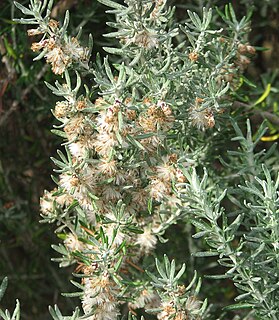
Alectryon is a genus of about 30 species of trees and shrubs from the family Sapindaceae. They grow naturally across Australasia, Papuasia, Melanesia, western Polynesia, east Malesia and Southeast Asia, including across mainland Australia, especially diverse in eastern Queensland and New South Wales, the Torres Strait Islands, New Guinea, the Solomon Islands, New Caledonia, New Zealand, Vanuatu, Fiji, Samoa, Hawaii, Indonesia and the Philippines. They grow in a wide variety of natural habitats, from rainforests, gallery forests and coastal forests to arid savannas and heaths.

Hakea is a genus of about 150 species of plants in the Family Proteaceae and are endemic to Australia. They are shrubs or small trees with leaves that are sometimes flat, otherwise circular in cross section in which case they are sometimes divided. The flowers are usually arranged in groups in leaf axils and resemble those of other genera, especially Grevillea. Hakeas have woody fruit which distinguishes them from grevilleas which have non-woody fruit which release the seeds as they mature. Hakeas are found in every state of Australia with the highest species diversity being found in the south west of Western Australia.

Commersonia is a genus of twenty-five species of flowering plants in the family Malvaceae. Plants in this genus are shrubs or trees, occurring from Indochina to Australia and have stems, leaves and flowers covered with star-like hairs. The leaves are simple, often with irregularly-toothed edges, the flowers bisexual with five sepals, five petals and five stamens and the fruit a capsule with five valves. The genus underwent a revision in 2011 and some species were separated from Commersonia, others were added from Rulingia.

Baeckea is a genus of flowering plants in the myrtle family, Myrtaceae. There are about 75 species, of which 70 are endemic to Australia; the others are distributed in New Caledonia and Southeast Asia.

Exocarpos is a genus of flowering shrubs and small trees in the sandalwood family, Santalaceae. They are found throughout Southeast Asia, Australia and the Pacific Islands.

Chamelaucium, also known as waxflower, is a genus of shrubs endemic to south western Western Australia. They belong to the myrtle family Myrtaceae and have flowers similar to those of the tea-trees (Leptospermum). The most well-known species is the Geraldton Wax, Chamelaucium uncinatum, which is cultivated widely for its large attractive flowers.

Calocephalus is a genus of flowering plants in the aster family, Asteraceae. It is endemic to Australia, where it is represented in every state.

Calytrix is a genus of shrubs in the family Myrtaceae described as a genus in 1806. They are commonly known as starflowers. Calytrix are endemic to Australia, occurring in the.

Thysanotus is a genus of perennial herbs in the family Asparagaceae, subfamily Lomandroideae. They are mostly native to Australia with 45 of the 50 known species occurring in Western Australia alone, although a few species range northward into New Guinea and Southeast Asia as far north as southern China.

Olearia axillaris is a shrub of the family Asteraceae, found in coastal areas of Australia. Commonly known as the coastal daisybush, or wild rosemary, it was one of the first Australian edible plants to be recognised as such by Europeans.

Chamaescilla is a genus of Australian herbs in the subfamily Hemerocallidoideae within the asphodel family. They have grass-like basal leaves and tuberous roots. The flowers have six petals and six stamens. The seed capsules contain black, glossy seeds.

Gyrostemon is a genus of shrubs or small trees in the family Gyrostemonaceae, endemic to Australia.
Minuria is a genus of annuals, perennials and dwarf shrubs in the aster tribe within the sunflower family.
Millotia is a genus of small annual herbs in the pussy's-toes tribe within the sunflower family.

Lasiopetalum behrii, commonly known as the pink velvet bush, is a shrub species which is endemic to southern Australia. It grows to 1.5 metre high and has long, narrow leaves which are between 4 and 9 cm in length and 0.5 to 3 cm wide. These have recurved edges and are rusty-tomentose on the undersides.

Chamaescilla corymbosa, commonly known as blue stars, blue squill or mudrurt, is a tuberous perennial herb species in the genus Chamaescilla. It is endemic to southern Australia.

Microcybe multiflora is a small shrub species in the family Rutaceae. The species is endemic to Australia. It usually grows to between 0.2 and 1 metre high and produces cream to yellow flowers.
Hollandaea is a genus of four species known to science, of Australian rainforest trees, constituting part of the plant family Proteaceae.
Grevillea pterosperma, commonly known as desert grevillea or desert spider-flower, is a flowering plant species in the family Proteaceae, endemic to Australia.

Codonocarpus cotinifolius a tall shrub or tree in the Gyrostemonaceae family is a found in all mainland states of Australia, including Victoria, and is widespread in arid areas. It is suspected of being toxic to stock.
















